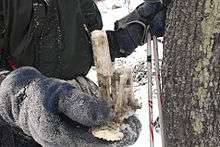Needle ice
.jpg)

Needle ice is a phenomenon that occurs when the temperature of the soil is above 0 °C (32 °F) and the surface temperature of the air is below 0 °C (32 °F). The subterranean liquid water is brought to the surface via capillary action, where it freezes and contributes to a growing needle-like ice column.
The ice needles are typically a few centimetres long. While growing, they may lift or push away small soil particles. On sloped surfaces, needle ice may be a factor contributing to soil creep.[1][2]
Alternate names for needle ice are "frost pillars" ("Säuleneis" in German), "frost column", "Kammeis" (a German term meaning "comb ice"), "Stängeleis" (another German term referring to the stem-like structures), "shimobashira" (霜柱, a Japanese term meaning frost pillars), or "pipkrake" (from Swedish pipa (tube) and krake (weak, fine), coined in 1907 by Henrik Hesselman).[3]
The similar phenomena of frost flowers and hair ice can occur on living or dead plants, especially on wood.

See also
References
- ↑ Isbell, D.: Needle Ice on Mt. Osceola, EPOD of July 10, 2005. URL last accessed 2007-12-07.
- ↑ Pidwirny, M.: Fundamentals of Physical Geography, 2nd ed., section 10(ag), Periglacial Processes and Landforms. URL last accessed 2007-12-07.
- ↑ Lawler, D. M.: "Some observations on needle ice", Weather, vol. 44, pp. 406–409; 1989.
Further reading
- Carter, James (2013). "Flowers and Ribbons of Ice". American Scientist. 101 (5): 360–69.
External links
![]() Media related to Needle ice at Wikimedia Commons
Media related to Needle ice at Wikimedia Commons